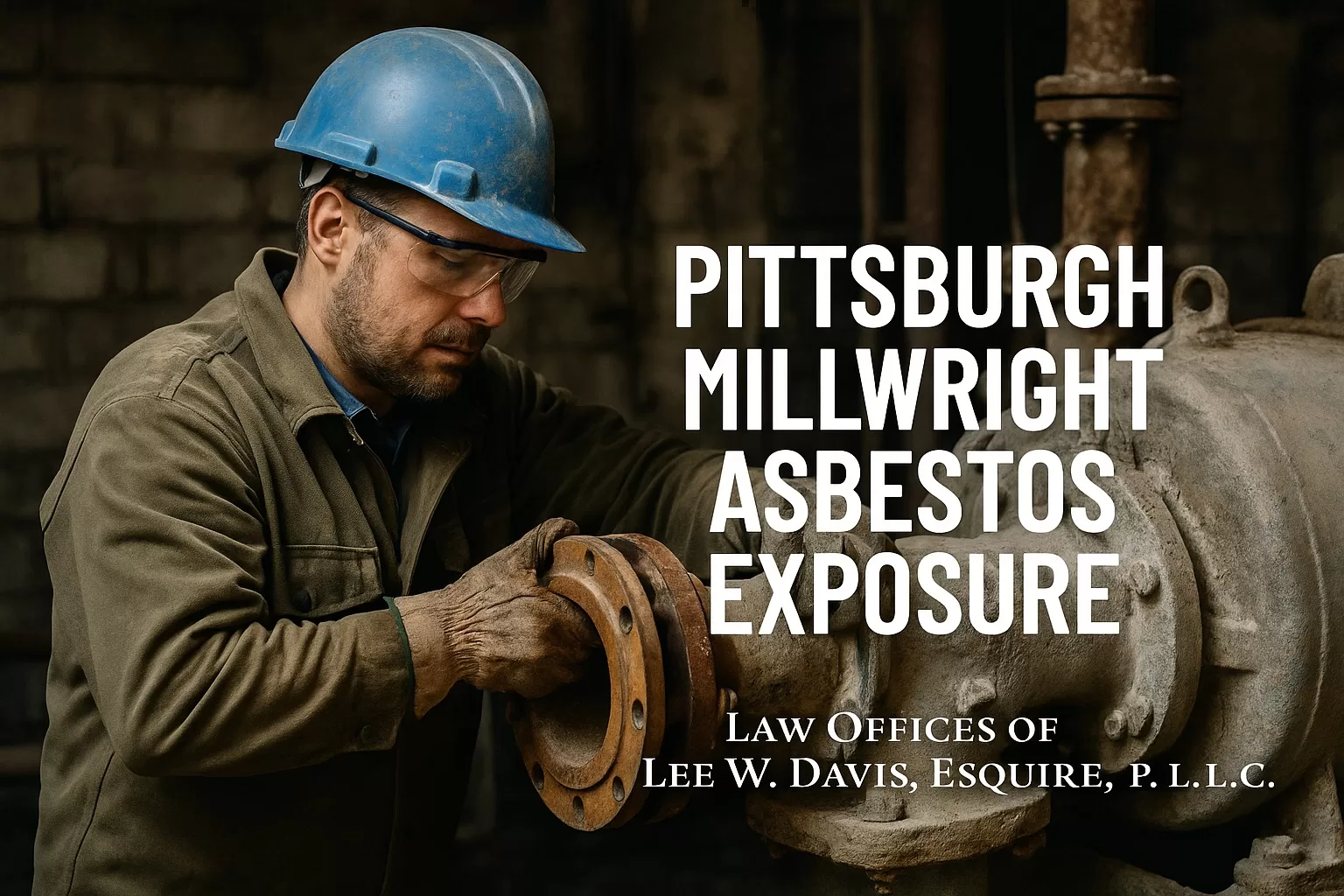Pittsburgh Millwright Asbestos Exposure has affected generations of workers across steel mills, power plants, chemical facilities, and industrial manufacturing sites throughout Western Pennsylvania. Millwrights were exposed more than almost any other trade because they installed, aligned, repaired, and rebuilt machinery wrapped in asbestos insulation. They also worked deep inside boiler rooms, turbine decks, pump houses, and mill floors where asbestos dust was thick in the air and embedded in the equipment they serviced.
Mesothelioma/Asbestos Legal Help – WV, MI & PA
Speak directly with attorney Lee W. Davis. No call centers. Free, confidential review.
Millwrights were the backbone of Pittsburgh’s industrial economy. Whether working in the mills, shutting down and rebuilding massive rotating equipment, or repairing power plant components during outages, they were constantly surrounded by asbestos-containing insulation, gaskets, packing, refractory material, and high-heat protective systems. Manufacturers knew the risks for decades, yet never warned the men doing the work.
Why Millwrights Faced Extreme Asbestos Exposure
1. Machinery Insulation and High-Heat Components
Millwrights serviced pumps, motors, turbines, compressors, blowers, gearboxes, and conveyors. Nearly all of these systems used asbestos for heat control and fire resistance. When millwrights opened up equipment for rebuilds, old insulation turned to dust.
2. Gaskets, Packing, and Seals
Millions of asbestos gaskets and packing rings were used throughout industrial facilities. Cutting, scraping, grinding, or removing these parts released fibers directly into the work area.
3. Power Plant Outage Work
Pittsburgh millwrights who worked outages at Cheswick, Bruce Mansfield, Elrama, Hatfield’s Ferry, and other plants encountered asbestos during every turbine tear-down, boiler repair, and valve rebuild.
4. Steel Mills and Foundries
From U.S. Steel Clairton to Edgar Thomson, Irvin Works, and the former J&L and Wheeling-Pittsburgh facilities, asbestos was everywhere. Millwrights worked inches away from deteriorated insulation on furnaces, coke ovens, and high-heat machinery.
5. Chemical and Manufacturing Plants
In facilities in Monroeville, Neville Island, Aliquippa, and the Ohio River corridor, asbestos insulation coated pipes, pumps, reactors, and process equipment millwrights had to access routinely.
Millwrights Face High Rates of Asbestos Disease
Because millwrights worked directly on asbestos-containing equipment, they are at elevated risk for:
- Mesothelioma
- Asbestos-related lung cancer
- Asbestosis
- Pleural disease
- Breathing impairment and chronic cough
Symptoms often appear decades after exposure. Many retired millwrights are only now discovering they were exposed.
Compensation Options for Pittsburgh Millwrights
Millwrights diagnosed with asbestos diseases may be eligible for:
- Asbestos trust fund claims
- Lawsuits against product manufacturers
- Significant confidential settlements
- Wrongful death claims for surviving families
Importantly, you do not sue your union or employer.
Claims target the manufacturers that supplied asbestos products.
Talk to an Attorney Who Understands Pittsburgh Job Sites
I have represented millwrights, steelworkers, power plant mechanics, and industrial tradesmen across Western Pennsylvania for decades. I know the equipment, the products, and the job sites — and I know exactly how the exposure occurred.
📞 Call 412-781-0525 for a free consultation.
You speak directly with me, not a case manager.
Check If Your Family Was Exposed
Get your free guide instantly + a confidential case review.
🔒 100% Confidential. No obligations.
Pittsburgh Millwright Asbestos Exposure – FAQs
1. How were millwrights in Pittsburgh exposed to asbestos?
Millwrights were exposed because they regularly repaired, aligned, and rebuilt machinery insulated with asbestos. Pumps, turbines, compressors, valves, and gearboxes often contained asbestos gaskets, packing, and high-heat insulation. When millwrights removed, scraped, or replaced these components, asbestos dust was released into the air and inhaled.
2. Which Pittsburgh job sites exposed millwrights to asbestos?
Millwrights were exposed at nearly every major industrial facility in Western Pennsylvania including U.S. Steel Clairton, Edgar Thomson Works, Irvin Works, J&L, Wheeling-Pitt, power plants like Cheswick and Bruce Mansfield, and chemical facilities on Neville Island and the Mon Valley. These job sites used large amounts of asbestos-containing insulation and mechanical components.
3. What asbestos diseases affect former millwrights?
Millwrights have elevated risks of mesothelioma, asbestos-related lung cancer, asbestosis, and pleural thickening. Because symptoms can take 20–50 years to appear, many millwrights develop disease long after retirement. Any millwright with shortness of breath, chronic cough, or chest pain should speak with an asbestos attorney and request medical screening.
4. Can millwrights file an asbestos claim without suing their employer or union?
Yes. Asbestos claims are filed against the manufacturers of asbestos products—not the employer, not the union (including the millwrights locals), and not the job site. Millwrights can pursue lawsuits and trust fund claims regardless of when the exposure occurred, and family members may file wrongful death claims if a millwright has passed away.
Mesothelioma/Asbestos Legal Help – WV, MI & PA
Speak directly with attorney Lee W. Davis. No call centers. Free, confidential review.

